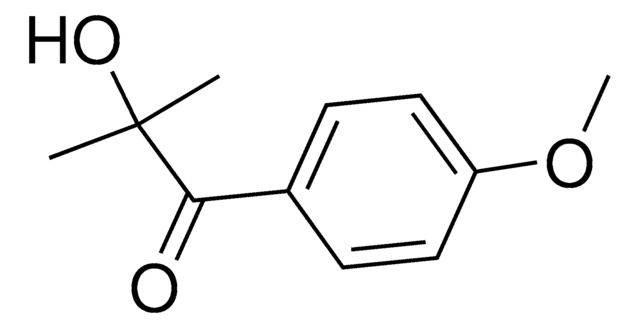The purity value of this product is approximately 99%, depending on the lot number. The percentage purity is calculated by High-Performance Liquid Chromatography (HPLC) using area ratios obtained from the chromatograms.
900889
Lithium phenyl-2,4,6-trimethylbenzoylphosphinate
≥95%
Synonym(s):
LAP
About This Item
Recommended Products
Quality Level
Assay
≥95%
form
crystalline powder
color
white to off-white
storage temp.
2-8°C
SMILES string
CC1=C(C(P(C2=CC=CC=C2)(O[Li])=O)=O)C(C)=CC(C)=C1
Looking for similar products? Visit Product Comparison Guide
Application
Features and Benefits
- Superior water solubility
- Biocompatible
- Sensitiveto visible light
Storage Class Code
11 - Combustible Solids
WGK
WGK 3
Flash Point(F)
Not applicable
Flash Point(C)
Not applicable
Choose from one of the most recent versions:
Already Own This Product?
Find documentation for the products that you have recently purchased in the Document Library.
Customers Also Viewed
Articles
Water-dispersible photoinitiator nanoparticles enable novel formulations for 3D bioprinting, tissue engineering, and device manufacturing.
Water-dispersible photoinitiator nanoparticles enable novel formulations for 3D bioprinting, tissue engineering, and device manufacturing.
Water-dispersible photoinitiator nanoparticles enable novel formulations for 3D bioprinting, tissue engineering, and device manufacturing.
Water-dispersible photoinitiator nanoparticles enable novel formulations for 3D bioprinting, tissue engineering, and device manufacturing.
Related Content
Tissue engineering fabricates tissues cultures from scaffolds, living cells, and biologically active molecules by simulating the microenvironment of the body to repair or replace damaged tissue.
Tissue engineering fabricates tissues cultures from scaffolds, living cells, and biologically active molecules by simulating the microenvironment of the body to repair or replace damaged tissue.
Tissue engineering fabricates tissues cultures from scaffolds, living cells, and biologically active molecules by simulating the microenvironment of the body to repair or replace damaged tissue.
Tissue engineering fabricates tissues cultures from scaffolds, living cells, and biologically active molecules by simulating the microenvironment of the body to repair or replace damaged tissue.
-
May I know the exact content for this product? (Purity(HPLC) is about the area ratio, right?)
1 answer-
Helpful?
-
-
What is the quantum yield of this photoinitiator for 365 nm light?
1 answer-
The quantum yield of this product at 365 nm is not tested. Here is a reference paper that reported the quantum yield of 0.35: https://onlinelibrary.wiley.com/doi/10.1002/macp.1991.021921010?msockid=09c4269466ab65c01be132a5675564f9
Helpful?
-
-
How is shipping temperature determined? And how is it related to the product storage temperature?
1 answer-
Products may be shipped at a different temperature than the recommended long-term storage temperature. If the product quality is sensitive to short-term exposure to conditions other than the recommended long-term storage, it will be shipped on wet or dry-ice. If the product quality is NOT affected by short-term exposure to conditions other than the recommended long-term storage, it will be shipped at ambient temperature. As shipping routes are configured for minimum transit times, shipping at ambient temperature helps control shipping costs for our customers. For more information, please refer to the Storage and Transport Conditions document: https://www.sigmaaldrich.com/deepweb/assets/sigmaaldrich/marketing/global/documents/316/622/storage-transport-conditions-mk.pdf
Helpful?
-
-
How can I determine the shelf life / expiration / retest date of this product?
1 answer-
If this product has an expiration or retest date, it will be shown on the Certificate of Analysis (COA, CofA). If there is no retest or expiration date listed on the product's COA, we do not have suitable stability data to determine a shelf life. For these products, the only date on the COA will be the release date; a retest, expiration, or use-by-date will not be displayed.
For all products, we recommend handling per defined conditions as printed in our product literature and website product descriptions. We recommend that products should be routinely inspected by customers to ensure they perform as expected.
For products without retest or expiration dates, our standard warranty of 1 year from the date of shipment is applicable.
For more information, please refer to the Product Dating Information document: https://www.sigmaaldrich.com/deepweb/assets/sigmaaldrich/marketing/global/documents/449/386/product-dating-information-mk.pdfHelpful?
-
-
Hello, I would like to know what is the minimum power to activate LAP?
1 answer-
Minimum activation levels are not determined for this product. As per the product information, this compound demonstrates increased polymerization rates with 365 nm light, and absorbance at 400 nm allowing for polymerization with visible light. See the link below for a publication that may be helpful.
https://www.ncbi.nlm.nih.gov/pmc/articles/PMC7408440/Helpful?
-
Active Filters
Our team of scientists has experience in all areas of research including Life Science, Material Science, Chemical Synthesis, Chromatography, Analytical and many others.
Contact Technical Service










